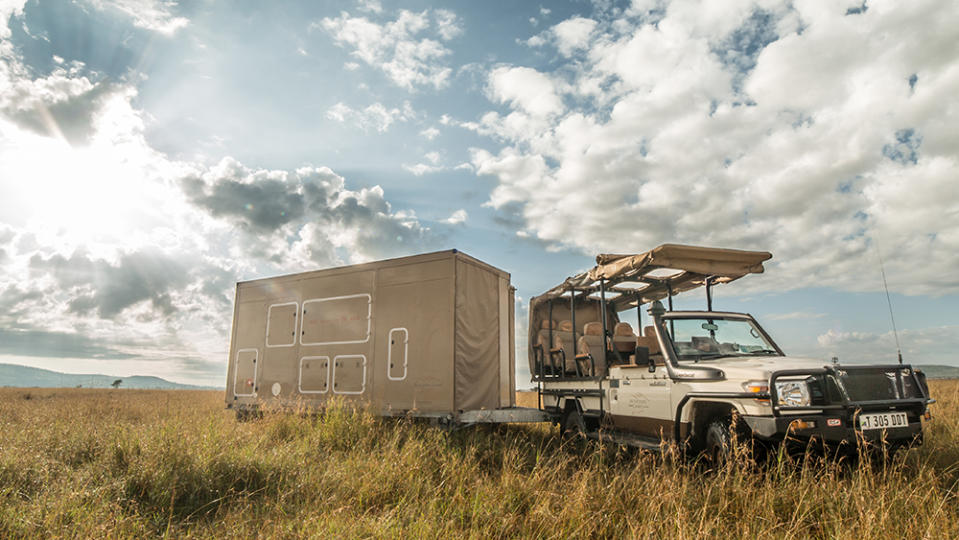This Mobile Safari Tent Unfolds Into a Luxe Sleeper No Matter Where You Camp

The rule for spotting game in the bush is to look for what doesn’t belong. In the shaggy green wild of the southern Serengeti, a flash of ivory snags the eye like silk on a nail. Could it be? Yes, it is—a rare sight among the fever trees and gnarled acacias: a hot tub.
It’s set into an elevated wraparound deck of Kenyan Meru oak in the shadow of a sprawling canvas sheet. There are lounge chairs and, around the corner, a small dining table with a bottle of Chenin Blanc perspiring in a silver bucket on starched white cloth. The en suite, when fully opened to the breeze, offers panoramic watercolor views from the king-sized bed and feels closer to being outside than in, notwithstanding the stocked bar, writing desk, walk-in shower, and Wi-Fi.
More from Robb Report
Mila Kunis and Ashton Kutcher Are Airbnb-ing Their Santa Barbara Cottage for $0
Despite Criticism, More People Than Ever Before Are Trying to Get 'Golden Visas' in Europe
So far, so safari lodge. But instead of sitting perched on some hill nestled between an infinity pool and a gift shop, we’re in the thick of Tanzania’s Serengeti National Park, poised at the edge of the tall grass where elephants roam and cat eyes glow back at you in the dark. Our spacious and perpetually mood-lit accommodation, over 1,000 square feet of something between a safari tent and a luxe tiny home, is improbably, ingeniously mobile, a remarkable design that folds into itself—lock, stock, and bathtub—like a magician’s trunk, becoming its own trailer that can be towed between campsites.

The Rover, from longtime Tanzania and Kenya operator Bushtops Safari Camps, is the brainchild of company founder Andrew Stuart, a fourth-generation safari pro who spent his youth indulging a passion for boats, working in shipyards and running maritime-tourism outfits off the coast of Mombasa, Kenya, where he still lives with his wife and Bushtops co-operator, Claudia. A marine engineer by trade, Stuart applied various boat-building efficiencies—cleverly engineered storage, stowable furniture, advanced materials—to a packable dwelling that does an uncanny impression of the serenely luxuriant abodes at Bushtops’ permanent camp in the northern Serengeti.
“Basically, it’s a boat on wheels,” Stuart says, noting that “the flush toilet, the water system, the pumping system” are all repurposed marine applications. Those gray slate walls in the shower? The stone is a mere two millimeters thick, bonded onto fiberglass to cut weight, like you’d find on a yacht.
The design process took over two years and was brought to life by Zurich-based architects Andrin Schweizer Company. Inside and out, everything hinges and snugs: The writing desk collapses, the shelving folds flat, and the bed frame stows away into its own headboard. The entire unit can be set up or disassembled in a day. One morning, we wake at sunrise to watch the whole operation pull stakes and head north, a caravan of Land Cruisers, each towing over five tons of hardwood, canvas, wicker, and stone neatly transmogrified into a large rectangular box. It’s not something most guests ever see—Roving Bushtops relocates between the southern and central Serengeti twice a year, following the seasonal migratory patterns of the millions of animals that continuously trek back and forth across the savanna, and travelers typically book one area or the other—but it helps to fully appreciate the slow, pulverizing, mud-caked grind of an overland African migration, whether for zebra or Toyota. By evening, following an extended game drive with Bushtops’ longtime head ranger, Deus Mitsetse, we slip into the tub of an identical Rover many miles north, part of a vanguard unit sent two days prior. Lit by an East African sunset, it’s the same soak with a different view, lush southern grassland replaced with the kopjes and low scrub of the central Serengeti plains, a herd of gazelle ambling past in the distance.

Camp, in either area, consists of eight Rovers—each solar-powered and using fresh water trucked in from the northern base’s water hole, to avoid depleting local resources—plus a large mess tent with a bar, a lounge, a portable wine “cellar,” and a dining room. Each Rover comes with personal butler service, and all guests enjoy a private truck for game drives, no matter how small the group. A Rover 2.0 is in the works: The sketches show a more modern color palette and an increased focus on textures, but within the same footprint. After all, the fundamental Rover design is bush-tested, and if Africa can’t break it, only a fool would try to fix it.
The unseen updates, instead, are mostly concerned with weight savings and ease of assembly and packing. Currently, setting up a single Rover requires a team of six. By cutting mass and further simplifying the moving parts, Stuart says, the Rovers could be even more transportable, require a smaller crew to prepare, and range yet deeper into the wild without sacrificing an iota of luxury.
“We’ve never had any feedback from customers about wanting more in terms of amenities or the overall experience,” he notes. “But if we could trim a few tons and make it able to be assembled by just a couple people, who knows? We could send individual Rovers on ahead into even more remote areas, along with mobile kitchens.” And bubbles for the hot tub, naturally.
Best of Robb Report
Sign up for Robb Report's Newsletter. For the latest news, follow us on Facebook, Twitter, and Instagram.


